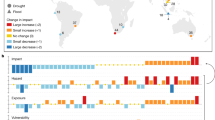Abstract
The debate in the United States about establishing a mechanism for insuring catastrophic wind risk at the national level pre-dates the intense 2004–2005 hurricane seasons. The prevailing argument against establishing any larger risk pool is that it would create a subsidy for the higher risk exposures. To determine whether benefits do accrue by aggregating catastrophic risk across increasingly wide geographic areas, the paper uses catastrophe models to evaluate the behavior of residential property portfolios within the state of Florida and for a larger risk pool that includes multiple combinations of coastal states in the southeastern United States. We find that geographic aggregation does not inherently subsidise high-risk exposures, reduces uncertainty, and reduces required reserves relative to total exposure for the least frequent and more severe events. This finding holds true for all state combinations evaluated in this study.











Similar content being viewed by others
Notes
These entries are abbreviated as aal, losscost, rp_aal, rp_1pct, and ra100, respectively in this and all subsequent tables in this paper.
E.g. Nyce and Maroney (2011).
Nutter (2002) provides some historical context of the difficulties that various private-public options for catastrophic risk have encountered in the time leading up to 9/11 and suggests that the role of government in financing catastrophes lacks a clear policy direction.
References
Anonymous (2006) ‘Long term solutions for Florida’s hurricane insurance market’, from www.myfloridacfo.com/hurricaneinsurancetaskforce/.
Cummins, J.D. (2006) ‘Should government provide insurance for catastrophes’, Federal Bank of St. Louis Review 88 (4): 337–379.
Cummins, J.D. and Trainar, P. (2009) ‘Securitization, insurance, and reinsurance’, The Journal of Risk and Insurance 76 (3): 463–492.
Doherty, N. (1997) ‘Innovations in managing catastrophic risk’, The Journal of Risk and Insurance 64 (4): 713–718.
Engeström, J. (1995) ‘Impact of catastrophes on the reinsurance industry’, The Geneva Papers on Risk and Insurance—Issues and Practice 20 (4): 463–473.
Grove, K. (2012) ‘Preempting the next disaster? Catastrophe insurance and the financialization of disaster management’, Security Dialogue 43 (2): 139–155.
Ibragimov, R., Jaffee, D. and Walden, J. (1999) ‘Nondiversification traps in catastrophe insurance markets’, The Review of Financial Studies 22 (3): 959–993.
Jaffee, D. and Russell, T. (1997) ‘Catastrophe insurance, capital markets, and uninsurable risks’, The Journal of Risk and Insurance 64 (2): 205–230.
Johnson, M. and Watson, Jr., C. (2011) Statistical Aspects of Hurricane Modeling and Forecasting, International Encyclopedia of Statistical Sciences, in M. Lovric (editor in chief), Springer, pp. 1388–1390.
Nutter, F.W. (2002) ‘The role of government in financing catastrophes’, The Geneva Papers on Risk and Insurance—Issues and Practice 27 (2): 283–287.
Nyce, C.M. and Maroney, P. (2011) ‘Are territorial rating models outdated in residential property insurance markets? Evidence from the Florida property insurance market’, Risk Management and Insurance Review 14 (2): 201–232.
Paudel, Y. (2012) ‘A comparative study of public-private catastrophe insurance systems: Lessons from current practices’, The Geneva Papers on Risk and Insurance—Issues and Practice 37 (2): 257–285.
Rothschild, M. and Stiglitz, J. (1976) ‘Equilibrium in competitive insurance markets: An essay on the economics of imperfect information’, The Quarterly Journal of Economics 90 (4): 629–649.
Sampson, C. and Schrader, A. (1997) The automated tropical cyclone forecasting system (Version 3.0), in 22nd Conference on Hurricanes and Tropical Meteorology, Boston, MA: American Meteorological Society, pp. 619–620.
Sampson, C. and Schrader, A. (2000) ‘The automated tropical cyclone forecasting system (Version 3.2)’, Bull. Amer. Met. Soc 81 (6): 1231–1240.
U.S. Census Bureau (2009) Design and Methodology, Washington DC: American Community Survey, US Government Printing Office.
Vaughan, E. and Vaughan, T. (2008) Fundamentals of Risk Insurance, 10th edn. Hoboken, NJ: John Wiley and Sons, pp. 160–161.
Watson, Jr C.C. and Johnson, M.E. (1999) ‘Hurricane return period estimation’, in T. Karl (ed.) Proceedings of the Tenth Symposium on Global Change Studies, Boston, MA: American Meteorological Society, pp. 478–479.
Watson, Jr C.C. and Johnson, M.E. (2002) ‘Using integrated multi-‐hazard numerical models in coastal storm hazard planning’, Solutions for Coastal Disasters ’02 Conference Proc Reston, VA: American Society of Civil Engineers, pp. 172–177.
Watson, Jr C.C. and Johnson, M.E. (2004) ‘Hurricane loss estimation models, opportunities for improving the state of the art’, Bulletin of the American Meteorological Society 85 (11): 1713–1726.
Watson, Jr C.C. and Johnson, M.E. (2007) ‘Fitting statistical distributions to data in hurricane modeling’, American Journal of Mathematical and Management Sciences 27 (3/4): 479–498.
Watson, Jr C.C., Johnson, M.E. and Dumm, R.E. (2012) The Impact of Geographic Diversification on the Viability of Hurricane Catastrophe Insurance, from http://www.stormrisk.org/sites/default/files/GeoDiversity_Final_Report.pdf, accessed 5 January 2013.
Watson, Jr C.C., Johnson, M.E. and Simons, M.M. (2004) ‘Insurance rate filings and hurricane loss estimation models’, Journal of Insurance Regulation 22 (3): 39–64.
Woo, G. (2001) ‘Territorial diversification of catastrophe bonds’, The Journal of Risk Finance 2 (4): 39–45.
Acknowledgements
The authors would like express their appreciation to the International Insurance Society, The Geneva Association, Kyobo Life, FSC, and GNAIE. Financial support for this research was provided by the Florida Catastrophic Storm Risk Management Center.
Author information
Authors and Affiliations
Additional information
This paper has been granted the 2014 Shin Research Excellence Award—a partnership between The Geneva Association and the International Insurance Society—for its academic quality and relevance by decision of a panel of judges comprising both business and academic insurance specialists.
E.g. Long Term Solutions for Florida’s Hurricane Insurance Market, 2006.
Rights and permissions
About this article
Cite this article
Dumm, R., Johnson, M. & Watson, C. An Examination of the Geographic Aggregation of Catastrophic Risk. Geneva Pap Risk Insur Issues Pract 40, 159–177 (2015). https://doi.org/10.1057/gpp.2014.20
Published:
Issue Date:
DOI: https://doi.org/10.1057/gpp.2014.20




